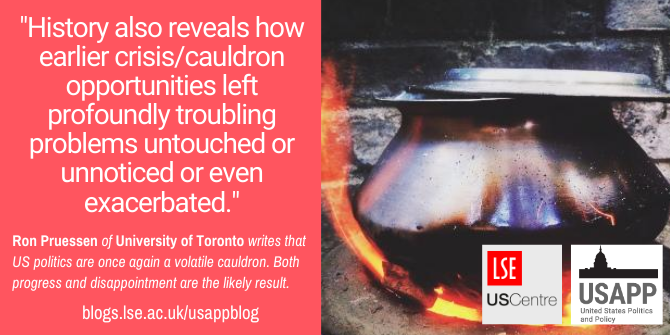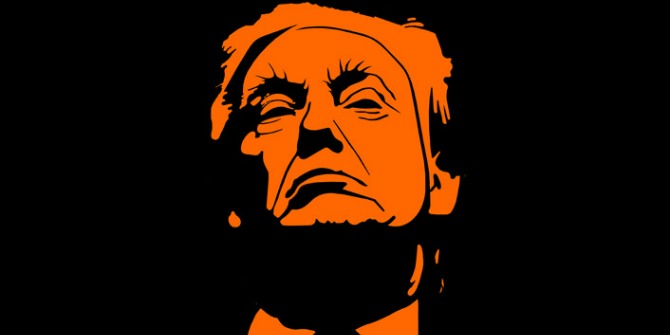 “It was the best of times, it was the worst of times…” Charles Dickens wrote the famous opening line of A Tale of Two Cities in 1859, but it feels very appropriate in the United States of 2020. But which of the two clauses deserves the most emphasis today? Ron Pruessen argues that history tells us that neither can be ignored. Looking to other volatile moments in America’s past reveals a repeated pattern of opposing forces which generate a frustrating blend of both splendid achievements and tragic failures.
“It was the best of times, it was the worst of times…” Charles Dickens wrote the famous opening line of A Tale of Two Cities in 1859, but it feels very appropriate in the United States of 2020. But which of the two clauses deserves the most emphasis today? Ron Pruessen argues that history tells us that neither can be ignored. Looking to other volatile moments in America’s past reveals a repeated pattern of opposing forces which generate a frustrating blend of both splendid achievements and tragic failures.
A cauldron bubbles in the heat of this American summer, with fistfuls of toxic ingredients furiously swirling. The protein-coated nucleic acid molecules of COVID-19 are there, of course. Any virus, however, must feed on living cells and Americans have offered up the ingredients needed to bring the pot to a scalding boil. Venom from the floundering viper in the White House and the sorcerer’s apprentices both inside and outside government (Mike Pompeo, Mitch McConnell, Ron DeSantis, Fox News’s Tucker Carlson, the religious right’s Franklin Graham, etc.). Cancer cells metastasized from the racism so deeply embedded in the country’s culture and politics. Lethal gamma rays radiating from the ever-increasing economic inequalities of recent decades. Among others.
The cauldron has too much of the “double, double, toil and trouble” of a Shakespearean tragedy for comfort. Yes, there are harbingers of happier possibilities: polls that suggest a win for former Vice President, Joe Biden in November and even a blue wave in Congress, local resistance to Trump’s pressure for full school openings, community discussions about police practices and restructuring, upticks in support for core values at the heart of #BlackLivesMatter. Encouraging things, to be sure – but the miasma emanating from the cauldron is still too pervasive to prompt confidence about a Midsummer Night’s Dream scenario pushing Macbeth off the stage. Trump is still in power, at the least, with too many loyal lieutenants, enablers, and users in all branches of the federal and state governments. Millions of citizens are refusing to adopt the common-sense precautions that would limit COVID-19’s devastation (with some of those citizens giving the president a shrunken but still frightening 42 percent approval rating). The failure to effectively manage the pandemic crisis also continues to wreak havoc on basic economic health, compounded by severe dislocations to the country’s education system. Puck, Titania, and Oberon will not be flying to the rescue any time soon.
American history is a story of forward movement and reversal
History underlines the need for sensitivity to the conflicted, half hopeful/half anxious currents of 2020. There have been other cauldron moments in American history, other periods of high crisis, including the Civil War, the Great Depression, and the civil rights and anti-war turmoil of the 1960s. Each saw a prolonged, complex working out of profound tensions. Each saw complex and compromised results.
Positive impacts were discernible in early cauldron experiences and they are justly celebrated: the end of slavery’s horrors; the New Deal’s “liberal” enhancement of government regulatory powers and social welfare programs (e.g., Social Security; the Securities Exchange Commission); advances like the Civil Rights Act of 1964 and the end of US involvement in Vietnam.

Photo by Ashad Mallick on Unsplash
But limits and reverses were always part of the stories, as well:
White Northern racism had permeated anti-slavery crusading – and contributed to the deconstruction of Reconstruction and the building of abusive Jim Crow systems.
The New Deal’s performance was seriously weakened in ways that Franklin Roosevelt himself would have recognized, with legislative plans increasingly stymied by conservative resistance in Congress and the courts by 1935-36. Social Security covered too few people and paid even those too little for decades – and it took World War II to more fully lighten the Depression’s burden on poor citizens.
And would anyone doubt – given recent developments, especially – that Black Americans were not able to achieve true “free at last” lives even after Lyndon Johnson’s achievements? The South did inch forward in some ways, but there have been regular efforts to limit and reverse changes (as in gerrymandering electoral districts, voter identification drives, and the culling of electoral rolls). Equally inhibiting to fuller progress, racist currents in the North burned more blatantly in controversies around “busing” and union membership (among many other examples). Richard Nixon compounded problems for the nation by devising a “southern strategy” that continues to warp the Republican Party.
Problems as yet unsolved
History also reveals how earlier crisis/cauldron opportunities left profoundly troubling problems untouched or unnoticed or even exacerbated. As Sherlock Holmes might put it, there were many dogs that did not bark in dark American nights – leaving tragedies including deaths and even murders all too common.
The Emancipation Proclamation and the 13th Amendment gave fuller resonance to the “all men are created equal” declaration of the founding fathers, but the patriarchal core of thinking and behavior remained fully dominant. Women voted nationally for the first time only in the 1920 elections, with full-fledged rights and opportunities remaining out of reach for decades. They are still often out of reach, of course, if attention is paid to wages (women earning 81 percent as much as men), top political and corporate leadership positions, and secure personal control of reproductive rights (among other “trailing” indicators).
Nor did the particularly severe problems of Black Americans over more than four centuries mean that other racial and ethnic groups were spared cruel and all too usual punishment. Civil War military heroes, for example, with vigorous government support, continued earlier campaigns to brutally force Native Americans into often desolate territorial corners. (General William Tecumseh Sherman added genocidal impulses into the mix, urging in one case that the government “must act with vindictive earnestness against the Sioux, even to their extermination, men, women, and children.”) Few Americans – even reformers – had strong concern for the violence against Asian immigrants, and did not flinch at federal laws that limited the arrival of Southern and Eastern European groups also seen as inferior. Post-World War II treatment of Latinos and post-9/11 hostility towards Muslims – at least within certain segments of the population and the Trump administration – again show the limited reach of earlier reform efforts.
The list could go on, of course:
Millions of Americans with disabilities remain short-changed – not completely ignored, but seriously under-supported by the social welfare advances of the 19th and 20th centuries. Consider the pressures on families dealing with autism or veterans struggling with grievous wounds and PTSD, for example. Those with disabilities are also particularly vulnerable to conservative budget cutting (as opposed to tax cuts) at the federal and state levels.
And LGBTQ+ Americans? Even after the 1970s, derogatory “n-word”-like labels signaled sharply negative perceptions of “deviance.” Jobs and community inclusion were long at risk (e.g., McCarthyism’s impact on government service and academic careers), prison sentences and police abuse were far from uncommon, and death could be at hand for hundreds like Wyoming’s Matthew Shephard (in 1998). Recent decades have seen increasing progress on this front, but the Trump years are making it clear that deep prejudices are far from fully uprooted (e.g., at least 26 transgender women were killed in 2018).
Positive change is often disappointingly slow
Why point out the limits of change in previous cauldron/crisis moments – and the gravity of problems lingering painfully through generations? It’s impossible for a historian – this historian, at least – to avoid doing so. This is not at all a counsel of despair. I honor many of the reforms and achievements mentioned here – and I look forward to seeing yet more progress shortly. At the same time, my celebration walks hand in hand with caution concerning both the speed and extent of the positive changes that appear to be in the offing. Even if the needs are tragically overdue for attention, the road immediately ahead may disappoint – as history has seen it do repeatedly – producing results more paced and limited than would be desirable.
It is not easy to balance eagerness and caution while relishing the exhilaration that is one part of a crisis/cauldron moment – especially when you want many of the reforms being urged. It is risky to fail to do so, however. One example: To expect full and quick results can lead to frustrating disappointments, a cynical walking away from struggles or even an angry turning on leaders who did not achieve all that was desired. Such perfectly human responses make it harder to deal with the resistance that is inevitable in campaigns for social, political, and economic justice. (Resisters are clearly present already and will remain on the lookout for opportunities to reverse even partial achievements.) Better to try to maintain the stamina and to aim for the wisdom of champions like Martin Luther King, Jr. – or John Lewis, whose recent death generated deserved praise from Americans enthusiastic about a new chapter in the struggle for democratic advances. Lewis knew, after decades of civil rights activism, that if progress was sweet it was also a fruit that could be painfully slow to mature. King knew about the inevitability of pain and protraction too, clearly capturing his nonetheless hopeful patience in his famous words: “Let us realize that the arc of the moral universe is long, but it bends toward justice.”
Please read our comments policy before commenting.
Note: This article gives the views of the author, and not the position of USAPP – American Politics and Policy, nor of the London School of Economics.
Shortened URL for this post: https://bit.ly/2COdgW2
About the author
 Ron Pruessen – University of Toronto
Ron Pruessen – University of Toronto
Ronald W. Pruessen has served as the Munk School of Global Affairs’ Director for International Partnerships & Research and is former Chair of the Department of History, University of Toronto. His primary research and teaching interests are in 20th century US foreign policy and international relations. Early work focused on the Cold War (e.g., John Foster Dulles: To the Threshold, 1888-1952) and he recently co-edited (with Soraya Castro) Fifty Years of Revolution: Perspectives on Cuba, the United States, and the World. His current book project is called Cakewalking with Tigers: Americans Choosing War and Making Mistakes, From James Madison to Donald Trump.






